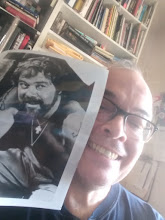


Friends of The United Provinces of Ivanlandia know we are big fans of “old school” special effects (and that includes superior gonzo makeup effects, as well!), that is to say, pre-CGI glut effects.
Anything that showed craftsmanship and ingenuity, of a level of engineering or artistic knowledge beyond simply one skill, well, that’s the stuff!
Effects that looked like they were hard work to accomplish—something that looked like it took effort and sweat, despite limited budgets.
Effects that oftentimes needed our willing suspension of disbelief—our desire to believe in the story—
Our heroes are L.B. Abbott, Derek Meddings, Dick Smith, Gene Warren, Willis O’Brien, Wally Veevers, Rick Baker, Eiji Tsuburaya, Doug Trumbull, and a host of others, not least of all,
The Fabulous Albert Whitlock (1915-1999).
 Mr. W is the matte painter’s matte painter.
Mr. W is the matte painter’s matte painter.More than super-scientific recreation, with a few strokes of the paintbrush, he created moods.
Albert Whitlock was a special effects man of the old school, and
there is a beauty and a grace to Whitlock's work that I've really yet to see in CGI flicks--not that they haven't come close sometimes, but whoever
was paying ILM or WETA that week still hasn't learned that some FX
shots NEED the camera to stand still.
Just because you can do a 375-degree flyby of the castle doesn't mean it should be done.
When approaching some large building, when was the last time you did a 375-degree flyby?
Right, never.
New Zealand Pete is the world’s biggest matte painting fan, and at his site he’s had several super-informative posts on Whitlock and his art (and yes, I did swipe several jpegs from NZP:
thanks!):
Whitlock & Mel Brooks’ History of the World Part One
(there are more effects in this picture than you thought!)
An exhaustive scrapbook (this will amaze you)

 Other New Zealand Pete entries on Whitlock include:
Other New Zealand Pete entries on Whitlock include:Whitlock & MacArthur
And
Whitlock & Earthquake (BTW: Much in the same way old school miniatures wizard L.B. Abbott—
who worked on ALL of Irwin Allen’s flicks: Abbott inferno’ed the tower, flipped the Poseidon, and piloted the Seaview—was in charge of in-house effects for Twentieth Century Fox,
Whitlock was the in-house genius for Universal Studios—which is why Big Al W.
got a major credit on a lot of flicks that only had one or two matte painting effects, like Michael Winner’s The Sentinel,
Michael Ritchie’s The Island, Eliot Silverstein’s The Car, John Carpenter’s The Thing, or Paul Schrader’s Cat People.
Not to say that Whitlock’s work wasn’t always welcome, and not trying to begrudge him some public recognition, but for example—I remember when I was a troubled youth going to see The Thing on its opening weekend (the same weekend as Blade Runner—which I went to see the same afternoon!), and being a tad disappointed that with such large credit placement (Whitlock was mentioned on The Thing’s poster!),
 he only contributed to about one scene:
he only contributed to about one scene:the flying saucer discovery—which is still awesome, and is perhaps a bad example to use,
but my point is that with such a prominent credit placement, mentally disturbed adolescents with a special effects fixation (me!) would feel disappointed that,
after his effects-laden work in flicks like Earthquake, The Wiz, The Hindenburg (more on that in a moment) and 1981’s History of the World Part One,
these other flicks would only have one or two matte shots, and sometimes, as in The Sentinel, the FX are completely unobtrusive and almost unnoticeable (which is to his credit, I’ll admit; Whitlock painted a series of apartment buildings and other outdoor locations to make it seem as if the film was all shot on location).
And this is after knowing that Whitlock often provided a slew of paintings and effects for a film, like Colossus: The Forbin Project, and only gets a tiny credit—
if one at all (Whitlock’s work in Diamonds Are Forever is uncredited, as are his great efforts in Hitchcock’s The Birds).
Anyway, blah-blah-blah; I always need to complain about something…

Whitlock really loved those castles (and mental institutions and Air Force radar installations) by the sea….




Star Trek owes much of its intergalactic architecture to Whitlock




“Oh, the humanity!”
The Hindenburg (1975)
Cast & Credits


The Robert Wise-directed The Hindenburg, released at the tail-end of the early- and mid-1970s “Disaster Movie” trend (a glorious genre of flick, if you ask me!),
is undoubtedly
Whitlock’s masterpiece.
His effects for Earthquake were flashier, and his later effects were “better,” but The Hindenburg really shows Whitlock's elegance.
Wise and Whitlock had worked together previously on the another Universal release, The Andromeda Strain (1971).
For The Hindenburg,
I’d say 99% of the shots of the mighty zeppelin, both inside and out, were matte paintings.
And they are perfect—in the sense that the matte paintings aid in transporting us to a bygone day of air travel that will never exist again; Whitlock’s matte paintings aren’t just details, they are moods and memories.
The film is a great/cheesy disaster/suspense/soap opera movie, based on a screen-story by the creators of Columbo.
George C. Scott is restrained as a "good" Nazi, Anne Bancroft is a hoot as an opium-smoking contessa, and there's practically every character actor you can imagine in a part (but no Elisha Cook, Jr! What the?!?).
The script strives for a "Casablanca of the Air" feeling, and sometimes succeeds.
Most of the exposition can be tuned out, and you can sit back and enjoy familiar faces sliding through a wonderfully designed film—
with several genuinely suspenseful, effects-heavy sequences.
Definitely one of the last products of the "Old" Hollywood—
director Robert Wise, a Hollywood veteran, brings a strong 1940s vibe—
The Hindenburg is especially worth a look for any nostalgia buffs.














































